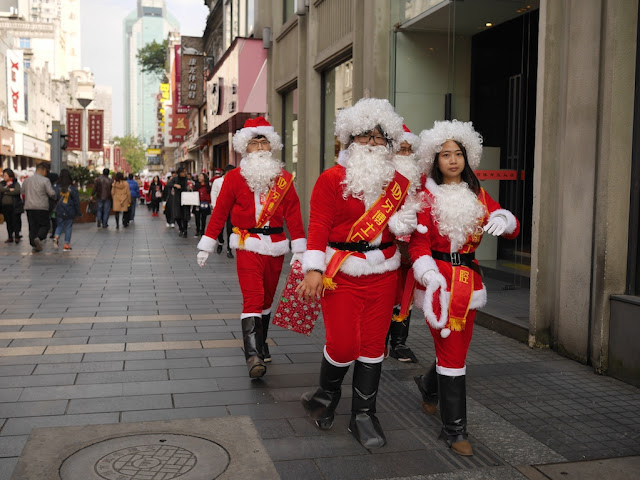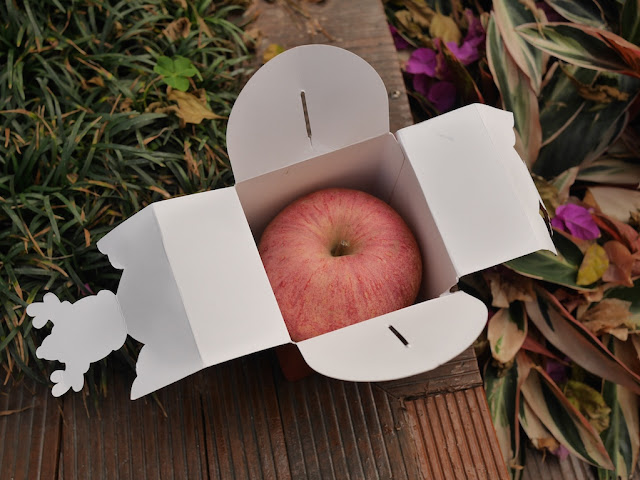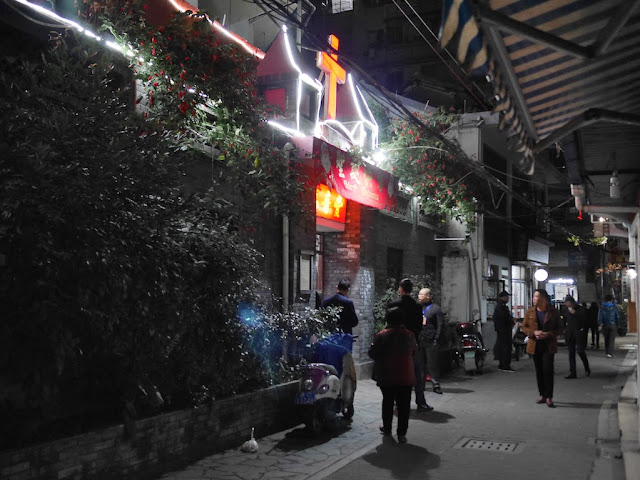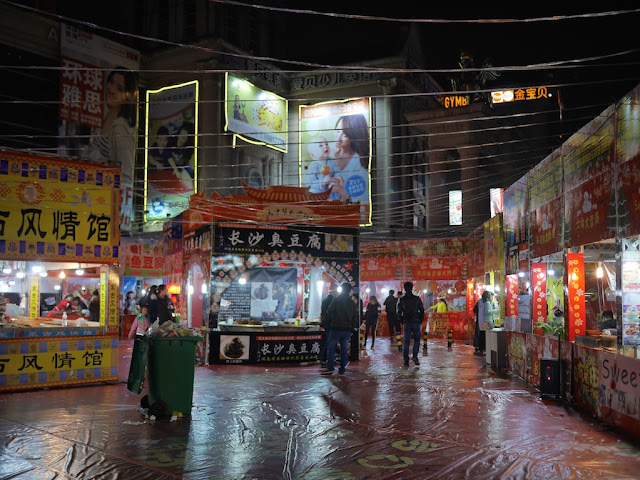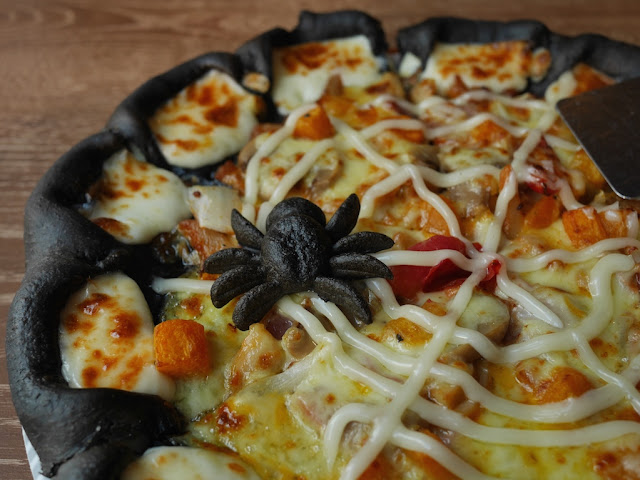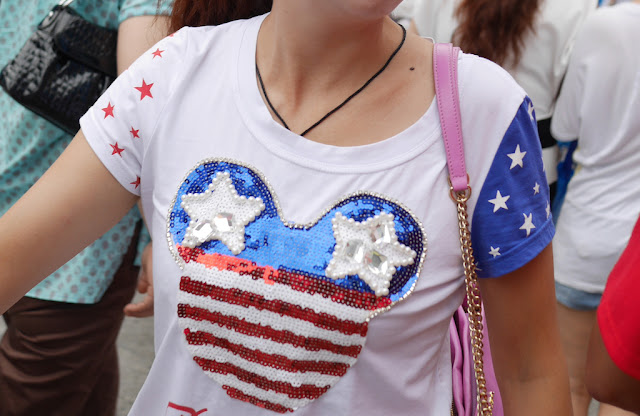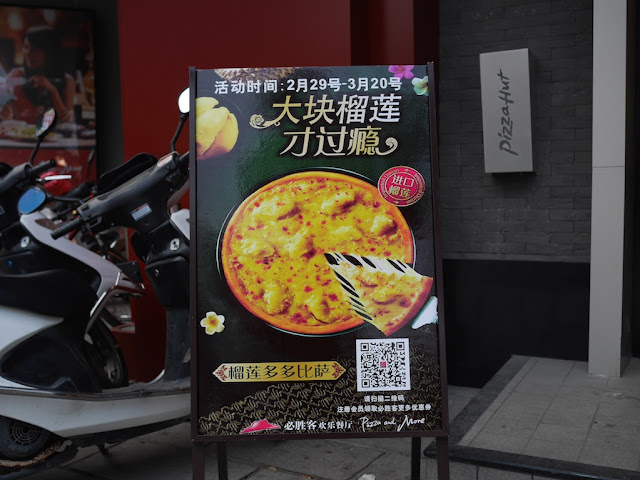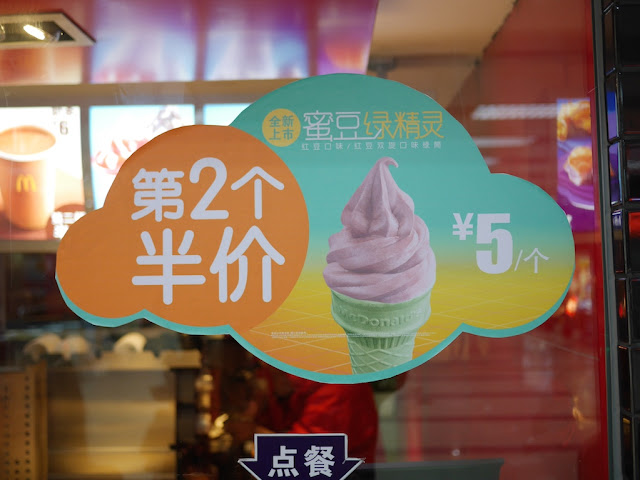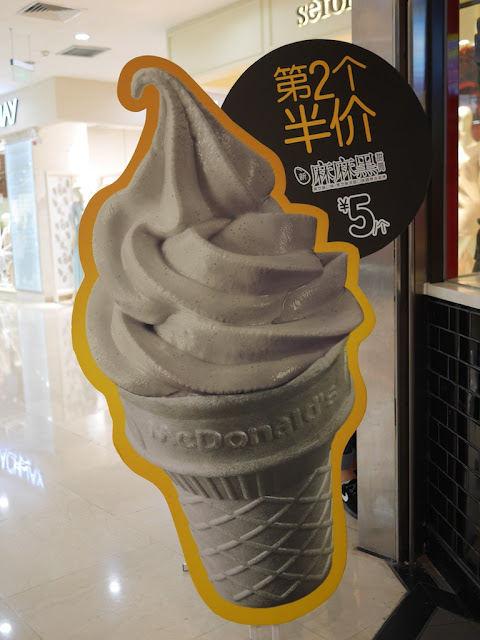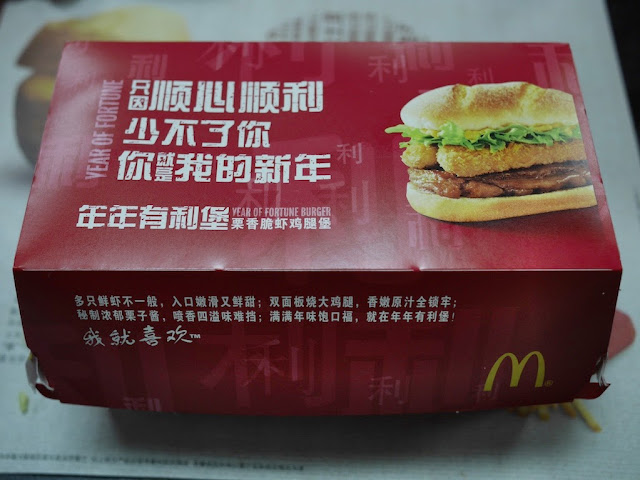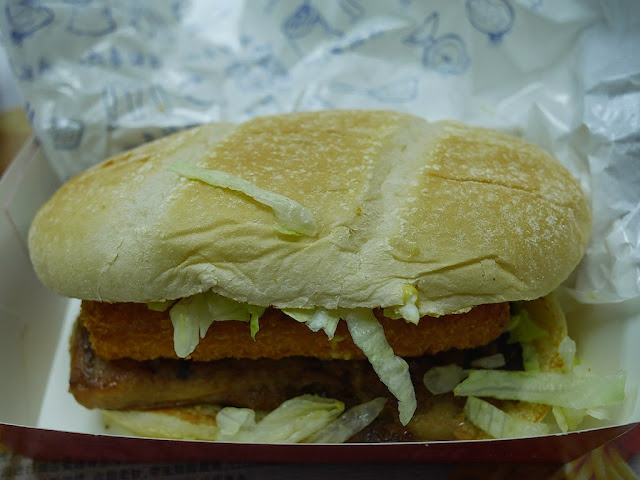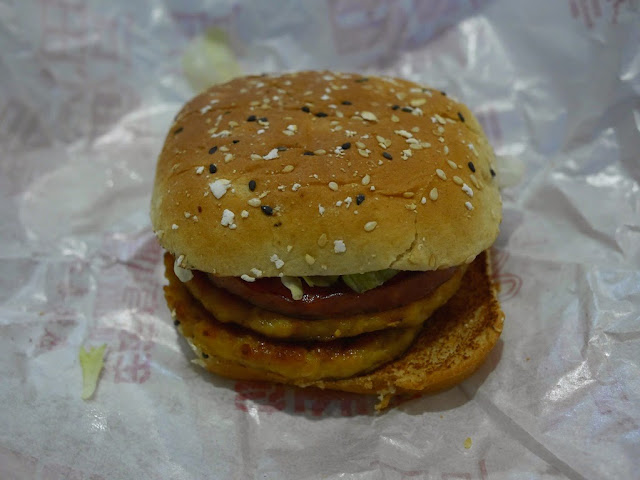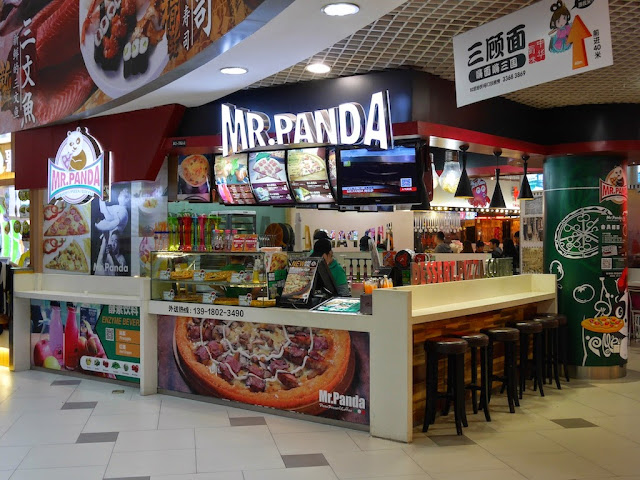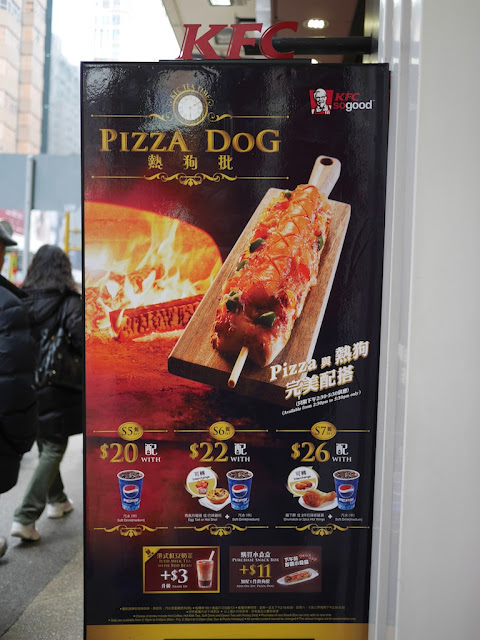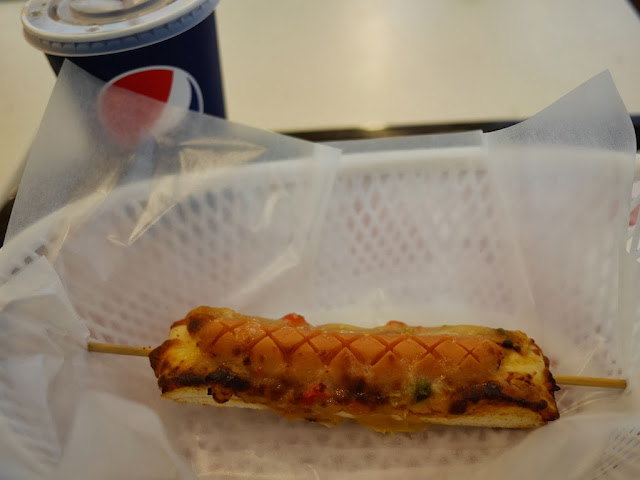Signs of the holiday were easy to spot the day before Christmas in Wenzhou, a city in Zhejiang on China's central east coast. In many ways, they were similar to what I had seen previous years in Wuhan, in Changsha, in Putian, and in Zhangzhou.
For example, in a central commercial district, there were numerous holiday promotions, including one with a "I have a dream!" theme at the Kaitai Department Store.
And several stores I passed had people dressed up as skinny Santas.
But I had never seen as many Santas together as I did at the Wuma Pedestrian Street. A parade of them kept coming . . .
And coming . . .
And coming . . .
And coming . . .
And coming . . .
And coming.
One of the Santas handed me a gift.
As soon as I had the box in my hand I realized it contained a Christmas apple — a tradition in China for Christmas Eve.
The Santas and their Christmas apples were part of a promotion for a dental clinic. I didn't get my teeth whitened, but the apple was good.
Christmas apples were for sale elsewhere, including at the Washi Lane wet market.
The Christmas holiday takes on a special significance in Wenzhou and elsewhere in Zhejiang due to recent forced demolitions of churches or removal of their crosses. I didn't seek out any churches, but I did stumble upon a small one on an alley off of Dasheng Lane.
When I first passed by I noticed two men wearing unmarked uniforms standing nearby. Other people greeting guests encouraged me to come inside. They said photography was fine and pointed out the church's ceiling.
There were approximately 150 people seated inside. I stuck around for a couple of songs.
As I left, I noticed an unhappy-looking policeman talking to the greeters outside. I didn't stick around to listen. When I passed by the area later, the church was still active and a policeman was keeping an eye on things nearby. It was a far different scene from the 30+ police I saw at a larger church in Quanzhou four years ago.
Not far away on Shuomen Old Street, the Hello K.T. bar had special Christmas all-you-can-drink deals.
After not drinking all I could drink, I saw two people who were wearing a type of headgear I had seen a number of others wearing for the holiday.
Yes, those are devil horns. No, I don't know how wearing them became a thing. My guess is their red color simply fits in. And lights. It is worth pointing out that for most people in China Christmas is mostly a chance to have some fun and there is no religious meaning attached.
To top things off that day, I stopped by a food fair at Wenzhou's European City.
A number of the booths were decorated for the holiday.
And a few people there were full of holiday spirit.
Most of the holiday spirit I saw on Christmas day was just more Santas and sales. But at the Wuma Pedestrian Street I saw my favorite Christmas holiday sight this year: two dressed-up children enthusiastically attacking their amused mother (I presume) with weapons made from balloons, a stick, and a giant inflatable pencil. They happily agreed to pose for an action photo.
Maybe this will give rise to a new holiday tradition in China.
For example, in a central commercial district, there were numerous holiday promotions, including one with a "I have a dream!" theme at the Kaitai Department Store.
And several stores I passed had people dressed up as skinny Santas.
But I had never seen as many Santas together as I did at the Wuma Pedestrian Street. A parade of them kept coming . . .
And coming . . .
And coming . . .
And coming . . .
And coming . . .
And coming.
One of the Santas handed me a gift.
As soon as I had the box in my hand I realized it contained a Christmas apple — a tradition in China for Christmas Eve.
The Santas and their Christmas apples were part of a promotion for a dental clinic. I didn't get my teeth whitened, but the apple was good.
Christmas apples were for sale elsewhere, including at the Washi Lane wet market.
The Christmas holiday takes on a special significance in Wenzhou and elsewhere in Zhejiang due to recent forced demolitions of churches or removal of their crosses. I didn't seek out any churches, but I did stumble upon a small one on an alley off of Dasheng Lane.
When I first passed by I noticed two men wearing unmarked uniforms standing nearby. Other people greeting guests encouraged me to come inside. They said photography was fine and pointed out the church's ceiling.
There were approximately 150 people seated inside. I stuck around for a couple of songs.
As I left, I noticed an unhappy-looking policeman talking to the greeters outside. I didn't stick around to listen. When I passed by the area later, the church was still active and a policeman was keeping an eye on things nearby. It was a far different scene from the 30+ police I saw at a larger church in Quanzhou four years ago.
Not far away on Shuomen Old Street, the Hello K.T. bar had special Christmas all-you-can-drink deals.
After not drinking all I could drink, I saw two people who were wearing a type of headgear I had seen a number of others wearing for the holiday.
Yes, those are devil horns. No, I don't know how wearing them became a thing. My guess is their red color simply fits in. And lights. It is worth pointing out that for most people in China Christmas is mostly a chance to have some fun and there is no religious meaning attached.
To top things off that day, I stopped by a food fair at Wenzhou's European City.
A number of the booths were decorated for the holiday.
And a few people there were full of holiday spirit.
Most of the holiday spirit I saw on Christmas day was just more Santas and sales. But at the Wuma Pedestrian Street I saw my favorite Christmas holiday sight this year: two dressed-up children enthusiastically attacking their amused mother (I presume) with weapons made from balloons, a stick, and a giant inflatable pencil. They happily agreed to pose for an action photo.
Maybe this will give rise to a new holiday tradition in China.




